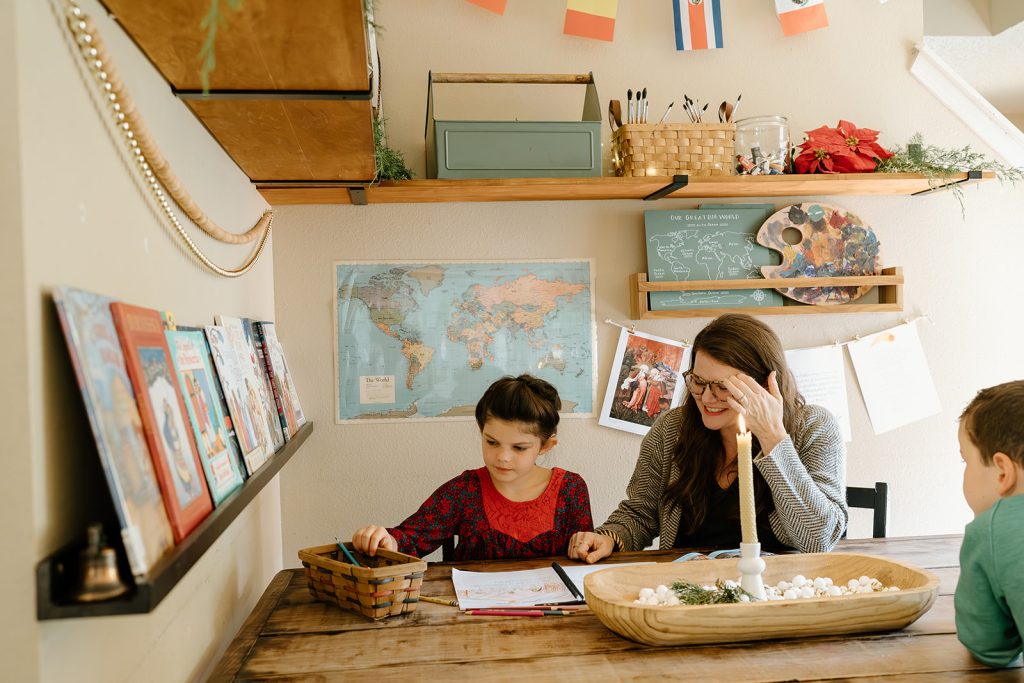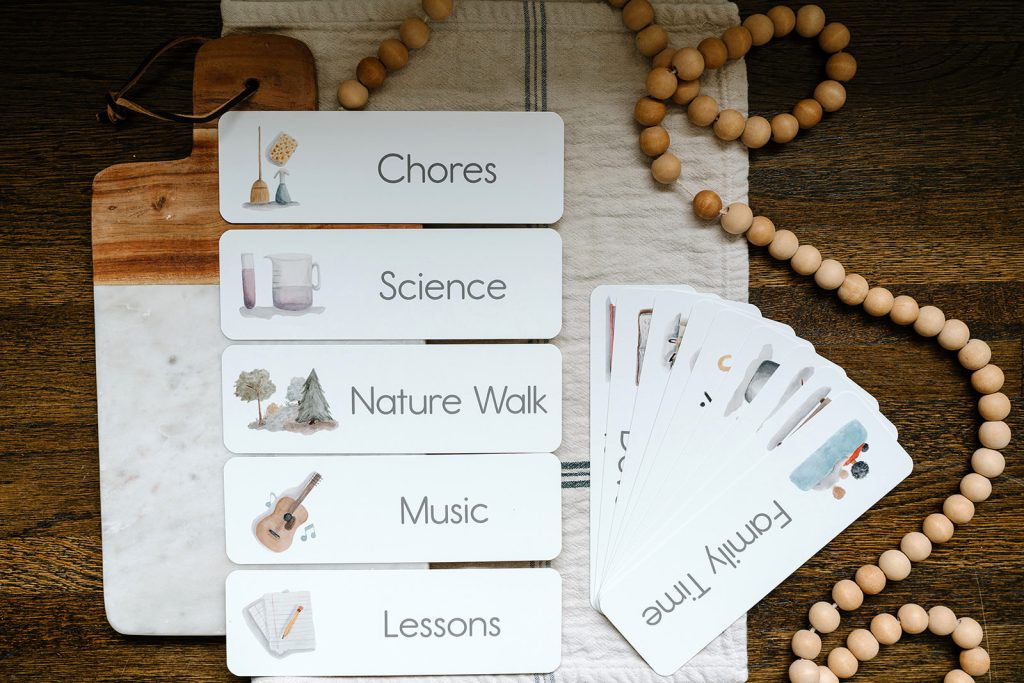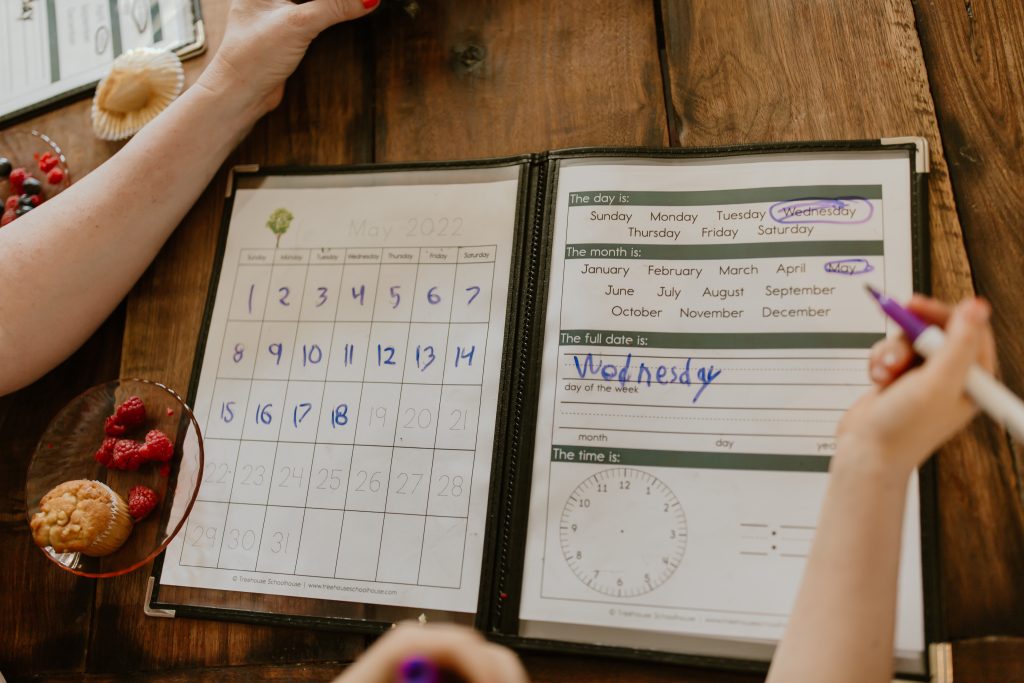Maybe you are considering taking the leap or you have just jumped into making the weighty decision to be a home-educating family. Either way, you probably feel the full spectrum of emotions, from anxious and overwhelmed to excited for what couple possibly unfold.
This post is all about the practical steps to take if you are considering homeschooling. While there are certainly more things you can and will do to prepare, these are my top seven!
In this blog post:
- Seven steps to begin homeschooling
- Beloved homeschool learning resources from Treehouse Schoolhouse
Seven steps to begin homeschooling

Step 1: Research educational philosophies and determine what resonates with you
There are roughly seven homeschool philosophies out there, but most people resonate components of multiple styles, rather than being true to just one. Here are the different philosophies you may want to dig deeper into:
- Classical
- Charlotte Mason
- Montessori
- Waldorf
- Unschooling
- Unit Studies
- Traditional
I recommend reading blogs and books, and listening to podcasts about these different methods to decide what you value in their approaches. Write these things down to begin forming the vision for your own home education. I recommend really considering what your goals and priorities are and writing a family vision statement, specific to home education. This will give you a plumbline to come back to when days are hard or you feel lost.
Take this free quiz to help you determine what homeschool style or educational philosophy you are.
Step 2: Choose homeschool curriculum

Once you’ve narrowed in on philosophies you want to be a part of your homeschool, it is much easier to begin looking for curriculum. You can rule out any curriculum companies that don’t offer education in a way you connect with. If you are able to attend a homeschool conference or visit a homeschool consignment store, flipping through and looking at curriculum is really helpful. Some companies offer a complete curriculum that includes every subject, but I find that the majority of homeschoolers piece curriculum together to make up their children’s school year.
As a home educator who leans heavily into a Charlotte Mason-style, here are some of my favorite curricula I have used over the years.
Pre-K and Kindergarten core curriculum
- Treehouse Nature Study, Primary Years
- Treehouse Story School: Preschool
- Sonlight
- Before Five in a Row and Five in a Row
Elementary core curriculum and history
Phonics, reading, and handwriting
- My Father’s World – In particular, Learning God’s Story for 1st Grade reading and phonics
- Dash into Learning
- Handwriting Without Tears (read my full review here)
- Explode the Code (read my review in this blog post)
- ABC See Hear Do
Math
- The Good and The Beautiful (the younger years)
- Math U See
- Right Start Math
- Teaching Textbooks (read my review here)
- Saxon Math
Science and Nature Study
- Exploring Nature With Children
- Treehouse Nature Study, Primary Years – Geared for preschool and elementary
- Treehouse Nature Study, Intermediate Years – Designed for 4th through 8th grades
Step 3: Seek out homeschool knowledge and inspiration

Read books, listen to podcasts, and follow Instagram accounts, bloggers, and authors who align with your beliefs about education and inspire you. You may want to begin doing that while on the hunt for curriculum because you may find recommendations on your way. I have discovered so many ideas and curriculum through authors, Instagram, and bloggers. Take notice of what stands out to you as you observe other mamas that have been homeschooling awhile. What about their home education attracts you? Add these things to your vision statement.
If I could narrow it down to five home education books that have inspired my journey, they would be:
- Educating the Wholehearted Child by Clay Clarkson and Sally Clarkson
- For the Children’s Sake by Susan Schaeffer Macaulay
- Teaching from Rest by Sarah Mackenzie
- The Brave Learner by Julie Bogart
- Awaking Wonder by Sally Clarkson
Step 4: Create a daily rhythm for your family

I recommend creating a daily rhythm that creates space for what you value and the responsibilities you have in your family. A daily rhythm is so much more than a “school time schedule.” It is more of a life schedule that weaves lessons into it.
Daily Rhythms will vary greatly from family to family, depending on ages of children and the amount of home care and other commitments you may have. Remember that you are not recreating a classroom environment in your home. Your children do not need 8 hours of instruction! I have written many posts about our family’s daily rhythm over the years, as it is constantly shifting as we change and grow. Hopefully some of these posts will give you ideas of where to begin. Here are a few at various stages of life in our family.
Step 5: Set the environment for your homeschool

Some people have designated homeschool rooms and many families homeschool at their dining room table or all over their homes. I personally have found that at least having a space near the dining room table or in a designated spot in the house for all of our school materials is helpful. If you don’t have a ton of extra space to work with, check out this blog post on how to homeschool in a smaller space. Your curriculum will have materials lists, but visit my Amazon storefront to get a peek into some of my favorites.
Step 6: Find a real-life homeschool community

The options vary from city to city, but go on a hunt for real-life homeschool community. A few places to start are a homeschool co-op, sports groups, and homeschool classes like music or art at local studios. You may also consider finding a weekly group such as a Wild + Free Community Group. These groups are all over the world and the main goal is community.
Step 7: Learn your state’s homeschool laws

Homeschool laws are regulated per state, so you need to know what the local law requires of you and your child. Some states require a certain number of college credits from the parent who will be teaching them, while others require a high school diploma. Most states will require that you officially declare your intent to homeschool and possibly name your school. Some states require attendance tracking, yearly testing, and/or a teacher’s evaluation. Some states have virtually no requirements at all. You can find out about your state’s requirements here.
Once you have discovered what the laws are in your state, you can begin the process of adhering to them by setting up systems in your home, such as a simple attendance tracker in your lesson planner or a filing system for your children’s work portfolio if that is a requirement. I simply keep a record of our lessons by using this planner.
I hope this post has been helpful for you in starting your homeschool journey! Here are some other posts I think you may find helpful:
Beloved homeschool learning resources from Treehouse Schoolhouse
Are you looking for more learning resources for your homeschool? Consider these best-selling products from Treehouse Schoolhouse that offer a gentle invitation to learning.
Treehouse Story School: Preschool

Treehouse Story School: Preschool is 32-weeks of gentle, literature-based curriculum designed for ages 2.5-5 years. This preschool curriculum that invites children to learn through the themes in stories they love. Each week will focus on a picture book, inviting children into connection and learning through music and movement, play-based narration, alphabet and number play, motor skills, practical life development, crafts, and baking together.
It would be a great fit for your toddler or preschooler if you are looking to incorporate multi-sensory, play-based learning while introducing them to timeless stories.
From toddler through upper preschool, this curriculum can be used year after year as you dive deeper into beloved, classic stories your family will cherish. Preview a free week here.
Daily Rhythm Bundle

Children are highly visual–they can feel particularly out of control when they don’t know what to expect of their day. That’s why we recommend using a visual schedule to support your children from the time they are very young.
Rather than trying to stick to a rigid schedule, this set helps you create a general rhythm for your days. The daily rhythm worksheet is laminated and dry erase and the cards can be moved around offering you flexibility and adaptability.
Morning Time Bundle

This interactive, reusable set focuses on weather, seasons, moon phase, temperature, weather-appropriate clothing, date and time, and reading a calendar. With this daily bundle, your child will practice the skills of handwriting, tracing, copywork, and telling time. I recommend you print these materials and place them inside of a Morning Time Menu or dry-erase sleeve. Using dry-erase markers, your child can fill this bundle out over and over again.
We also offer a version of the Morning Time Bundle for those in our community who live in the Southern Hemisphere.
Treehouse Nature Study, Primary Years

Treehouse Nature Study, Primary Years invites children to connect with each other and the world around them through living books, nature notebooking, hands-on projects, and beauty subjects such as poetry, picture study, and folk songs. From preschool through upper elementary, the study appeals to every age and is easily used with multiple ages at the same time.
It would be a great fit for your preschool or kindergartener’s core curriculum or your whole family’s home education Morning Time and Nature Study. It also provides supplemental work for your children’s language arts through poetry memorization, recitation, copywork, and notebooking.
Treehouse Nature Study, Intermediate Years

Treehouse Nature Study, Intermediate Years is an advanced, seasonal nature study designed for older children. This curriculum invites older children to connect with each other and the world around them through living books, nature notebooking, hands-on projects, poetry, and picture study. Deepen your child’s learning through advanced language arts and scientific experiments.
It would be a great fit for your upper elementary or middle schooler’s science curriculum or your whole family’s home education Morning Time and Nature Study. It also provides supplemental work for your children’s language arts through poetry copywork, creating an Illustrated Science Dictionary, creative writing prompts, notebooking, and internet research.



![Why Kids Should Still Read Fairy Tales Today [Free Booklist]](https://storage.googleapis.com/treehouse-schoolhouse-media-dev/8901dcb1-img_6905.jpg)